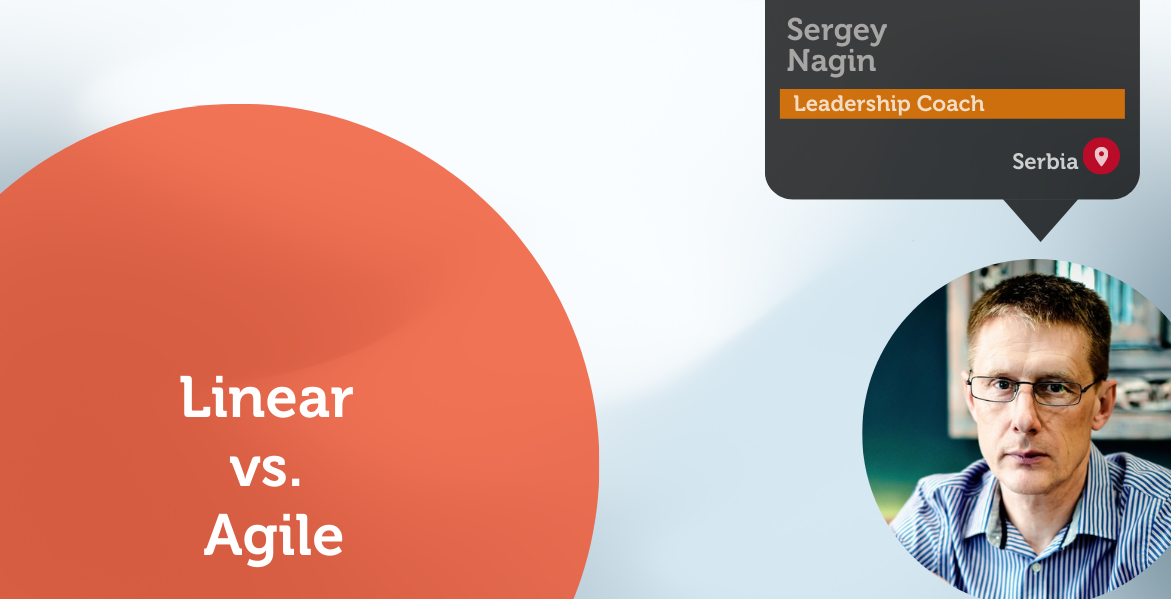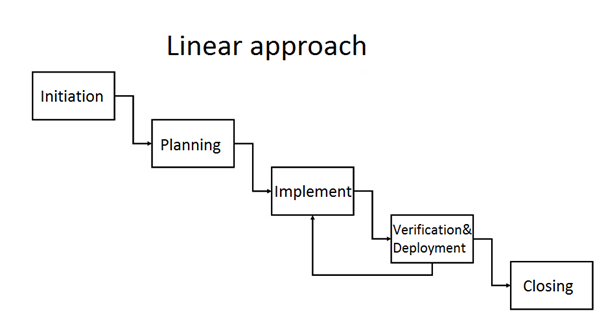A Coaching Power Tool By Sergey Nagin, Leadership Coach, SERBIA

Linear vs. Agile Method of Management
In the practice of solving tasks of regular management, as well as in project work, the linear method of management has been traditionally used for decades. However, in the context of constant changes in the external environment and the related customer requirements for product characteristics, the linear method turns out to be ineffective, as it has a large inertia and does not allow for quick changes.
To meet the changing conditions in February 2001, a group of enthusiastic software developers formulated the Agile Manifesto, which includes 4 values and 12 principles.
In this paper, I will explore the possibility of applying an Agile approach to the daily work of a coach with clients and analyze how this Power tool can help transform the client’s approach to solving their problems within the coaching interaction.
Explanation: Linear vs. Agile
What Is the Linear Approach to Solving Tasks?
(also called the Cascade or Waterfall model)

It consists of 5 process groups:
-
Initiation
The initial analysis of the project is carried out.
Fundamental questions are raised: what will we get as a result of the project, and what is the cost and duration of the project?
When a positive decision is made to launch the project, there is a transition to step two:
-
Planning
All the nuances and details of the project are worked out in detail
-
Implementation
Work is carried out according to the plan
-
Verification and Deployment
Performance is audited and, if necessary, adjustments are made
-
Closing
The transition of the project to the customer, and finalization of mutual obligations under the project.
General features of the Linear approach:
- strict alternation of stages
- the low ability to adapt to change
- may be out of date by the end
- limited interaction with the client
What Is the Agile Approach?

It consists of the same five process groups.
All processes lie at the same level and interact while being in operation in parallel.
General features of the AGILE approach:
- In planning, incomplete inputs are the norm, and the task may change over the lifetime of the project.
- The constant involvement of the client in the project
- Quick response to any changes
Linear vs. Agile Application
Along with considering the application of the AGILE approach to coaching clients, let’s take a look at its basic Values reflected in the Agile manifesto:
-
Individuals and Interactions Over Processes and Tools
Processes and tools are important, but a safe and trusting working environment in communication with the client is the top priority. People are the main value. The coach creates a space of trust and safety, reacts to a change in the emotional state of the client, and acts as a sounding board to the client.
-
Working Software (In Coaching It Is the Client’s Progress) Over Comprehensive Documentation
All interaction within the framework of coaching is carried out with one goal – to assure the client’s progress in achieving the stated goals of coaching (taking into account the possible change in goals associated with a deeper understanding of the essence of the goals and obstacles the client faces).
-
Customer Collaboration Over Contract Negotiation
Changes are welcome to maintain a constructive relationship with the client. There is no point in pursuing a goal that the client no longer needs. Maintaining the balance of win-win relationships.
However, in coaching, it is essential to make sure that Coaching Agreement is established and is clearly communicated between the coach and the client. Otherwise, this conversation between two individuals can not be considered coaching.
-
Responding to Change by Following a Plan
We respond to the current request of the client, regardless of what was originally stated as the goal of the session. In this case, the coaching Agreement for an individual session or even for the entire interaction with the client must be modified to match the real needs of the client.
During a coaching session, a situation may arise where the client expresses the conviction that in order to achieve his goal, a series of sequential linear barriers must be overcome. For example: for my career advancement, I need to complete training, get a degree, achieve the title of “best manager”, and submit all my reports before the deadline.
I have to gain more experience within the company. I need to prove myself for another 2-3 years. I need to wait for my boss to get promoted and then I can apply for the job.
Often, entire dams are built from such barriers on the way the client reaches his goal.
At the same time, this linear approach is not always the best option for the client.
Often the client may decide to act in several directions at the same time, to test and implement new ideas, to change their goals based on the changing conditions of the external environment. For example, a client may decide to send his resume to several companies instead of waiting for his boss’s chair to become vacant. Or to apply for vacancies in other departments that will give him an increase in responsibility and earnings.
Coaching: Linear vs. Agile Goal
Emotional agility is a process that enables us to navigate life’s twists and turns with self-acceptance, clear-sightedness, and an open mind. The process isn’t about ignoring difficult emotions and thoughts. It’s about holding those emotions and thoughts loosely, facing them courageously and compassionately, and then moving past them to ignite change in your life. Susan David, Author of Emotional Agility
In which ways Agile mindset may help the client to move forward:
- Looking around for the new opportunities
- Understanding how to respond to challenges in a flexible, Agile way
- Being ready to embrace change and adapt to the new conditions of the environment
- Readiness to learn more about himself and the situation
- Ability to treat oneself with an open mind and honesty
- Readiness for more open communication with peers and superiors
- Acceptance of the possibility of multiple correct answers to his challenges
Questions to ask to evoke an Agile mindset:
- What have you done about the situation already?
- What assumptions make you think (feel) this way?
- What are other possible solutions? What else?
- What have you not yet considered about the situation?
- What other options can you explore?
- What would it look like to approach this another way?
I believe that the application of the Linear vs. Agile Power tool in coaching helps the client to change his/her view on the essence of his Goal in coaching interaction in general as well as the coaching Agreement for a particular session. It also expands the client’s vision of perspectives, gets rid of the state of stuckness, and helps the client move towards the realization of their own life goals, instead of overcoming linear barriers set by the client himself or his environment.
References
Agile Manifesto
https://agilemanifesto.org
Agile Software Development
https://en.wikipedia.org/Wiki/agile_software_development
David, S. (2016). Emotional Agility: Get Unstuck, Embrace Change, and Thrive in Work and Life. New York, New York: Penguin Random House.
Reynolds, M. (2020). Coach the Person Not the Problem: A Guide to Using Reflective Inquiry. Oakland, CA: Berrett-Koehler Publishers, Inc.
Effective Problem-Solving and Decision-Making https://opentextbc.ca/Workinginfoodserviceindustry/Chapter/Effective-Problem-Solving-And-Decision-Making/